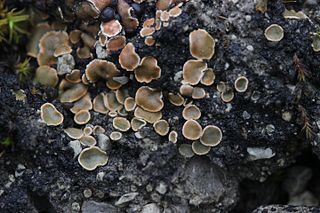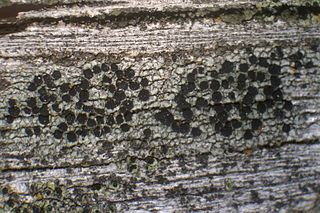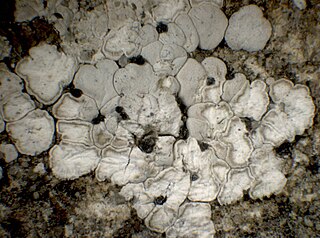
Psora is a genus of lichen-forming fungi in the family Psoraceae. Members of the genus are commonly called fishscale lichens. Lichens in the genus Psora generally have a squamulose thallus and anthraquinones in the hymenium. Photobiont partners of Psora lichens include members of the green algal genera Asterochloris, Chloroidium, Myrmecia, and Trebouxia.

Ochrolechia is the sole genus in the fungal family Ochrolechiaceae. It comprises about 40 species of crustose lichens. These lichens typically form uneven, often thick, crust-like growths on various surfaces and are characterised by their white to pale grey thalli, which may have a greenish tint. The genus has a long evolutionary history, with fossils dating back to the Paleogene period, about 34 million years ago. Ochrolechia species have disc-like apothecia, which are usually yellowish or brownish-pink and often covered with a fine white powdery coating. The genus is widely distributed and includes both common and rare species, with some found in extreme environments such as arctic and alpine regions. Ochrolechia lichens produce diverse secondary metabolites, including orcinol depsides, depsidones, and xanthones.
Lithoglypha is a fungal genus in the family Acarosporaceae. It is monotypic, containing the single species Lithoglypha aggregata, a saxicolous (rock-dwelling), crustose lichen found in South Africa.

Buellia is a genus of mostly lichen-forming fungi in the family Caliciaceae. The fungi are usually part of a crustose lichen. In this case, the lichen species is given the same name as the fungus. But members may also grow as parasites on lichens (lichenicolous). The algae in the lichen is always a member of the genus Trebouxia.

Arthonia is a genus of lichens in the family Arthoniaceae. It was circumscribed by Swedish botanist Erik Acharius in 1806.

Immersaria is a genus of lichen-forming fungi in the family Lecideaceae. It has eight species of crustose lichens.

Lathagrium is a genus of lichen-forming fungi in the family Collemataceae. It has 10 species of gelatinous lichens. Species in this genus typically grow on calcareous rocks, often amidst mosses, but can also be found on siliceous or serpentine rocks, mortar, or soil.

Roccellinastrum is a genus of lichen-forming fungi in the family Pilocarpaceae. It has seven species.
Sagiolechiaceae is a small family of lichen-forming fungi in the order Ostropales. It contains two genera, Rhexophiale, and Sagiolechia, the type genus.
Gyrotrema papillatum is a little-known species of corticolous (bark-dwelling), crustose lichen in the family Harpidiaceae. It is known from a single collection in a lowland rainforest region of Costa Rica.
Lecidea lygommella is a species of saxicolous (rock-dwelling), crustose lichen in the family Lecideaceae. It spreads up to 7 cm wide with a thin thallus varying in colour from whitish and pale grey to rusty red-brown, featuring areolate surfaces with irregularly shaped areoles. Its fruiting bodies range from slightly embedded to sitting atop the thallus and black, flat to slightly convex apothecial discs. Unlike its lookalike Lecidea lygomma, L. lygommella does not produce any secondary chemicals. It is found in New South Wales and Victoria, Australia, where it grows on rocks in alpine areas.

Flavoplaca oasis is a species of saxicolous (rock-dwelling), crustose lichen in the family Teloschistaceae. It is widely distributed across Europe, and has been reported in Western Asia, China, and North Africa.
Nitidochapsa is a genus of lichen-forming fungi in the family Graphidaceae. It has five species of corticolous (bark-dwelling), crustose lichens.

Glaucomaria carpinea is a species of corticolous (bark-dwelling), crustose lichen in the family Lecanoraceae. It is a widely distributed species.
Buellia subalbula is a species of saxicolous (rock-dwelling), crustose lichen in the family Caliciaceae. It occurs in coastal southern Africa, South America, and Australia, where it grows on calcareous rocks.

Porpidinia is a genus of lichen-forming fungi in the family Lecideaceae. It has two species of saxicolous (rock-dwelling) lichens. The type species of the genus, Porpidinia tumidula, thrives in a variety of settings from coastal to mountainous areas, primarily on lime-rich rocks, and is widely spread across southern to northern Europe, northern Africa, parts of Asia, and New Zealand. Meanwhile, Porpidinia brevispora is more regionally confined, found specifically in the Sikhote-Alin range in the Russian Far East, favouring carbonate rocks at lower altitudes.
Megaloblastenia is a genus of crustose lichen-forming fungi in the family Megalosporaceae, comprising three species. Proposed by Dutch lichenologist Harrie Sipman in 1983, the genus is characterised by its thick, ecorticate thallus ranging from pale whitish-grey to yellowish, and its disc-like fruiting bodies (apothecia) that can be biatorine or lecideine. Megaloblastenia lichens form a symbiotic relationship with Dictyochloropsis algae, produce hyaline, bicellular ascospores with polaribilocular structure, and contain chemical compounds such as zeorin, pannarin, or usnic acid. Found in Australasia and South America, these lichens typically grow as epiphytes on trees in moist forests within temperate to tropical oceanic climates.
Pseudopeltula is a genus of lichen-forming fungi in the family Gloeoheppiaceae. Established in 1995 by the lichenologist Aino Henssen, the genus currently includes four recognised species. These small cyanolichens are characterised by their squamulose (scaly) to peltate (shield-shaped) thalli, which lack a lower cortex and are attached to the substrate by rhizines. A key feature of Pseudopeltula is its complex apothecia, which have hymenia that often become divided by sterile tissue as they mature. The genus is primarily found in arid and semi-arid regions of North America, Mexico, and the Caribbean, where species typically grow on soil, rock, or thin soil over rock, often forming part of biological soil crusts in desert environments.
Parallopsora is a small genus of lichen-forming fungi in the family Ramalinaceae. Established in 2018, the genus contains three species that were previously classified under a related genus, Phyllopsora. These lichens form small, scale-like growths that overlap like roof tiles and typically appear pale green to bluish-green in colour. They reproduce through both small brown fruiting bodies and sometimes through powdery structures on their surface. The species are known to grow in tropical rainforests, particularly in Brazil, Peru and Cuba.









